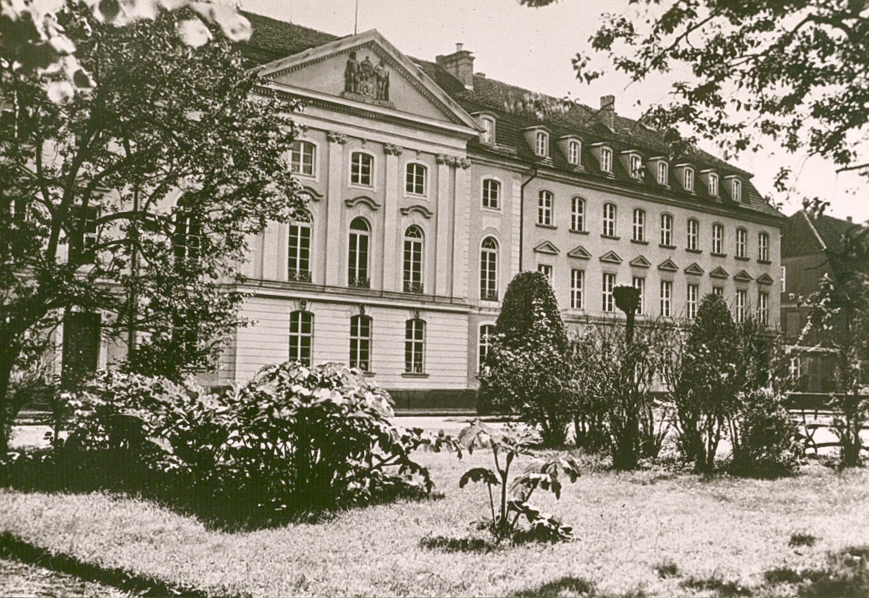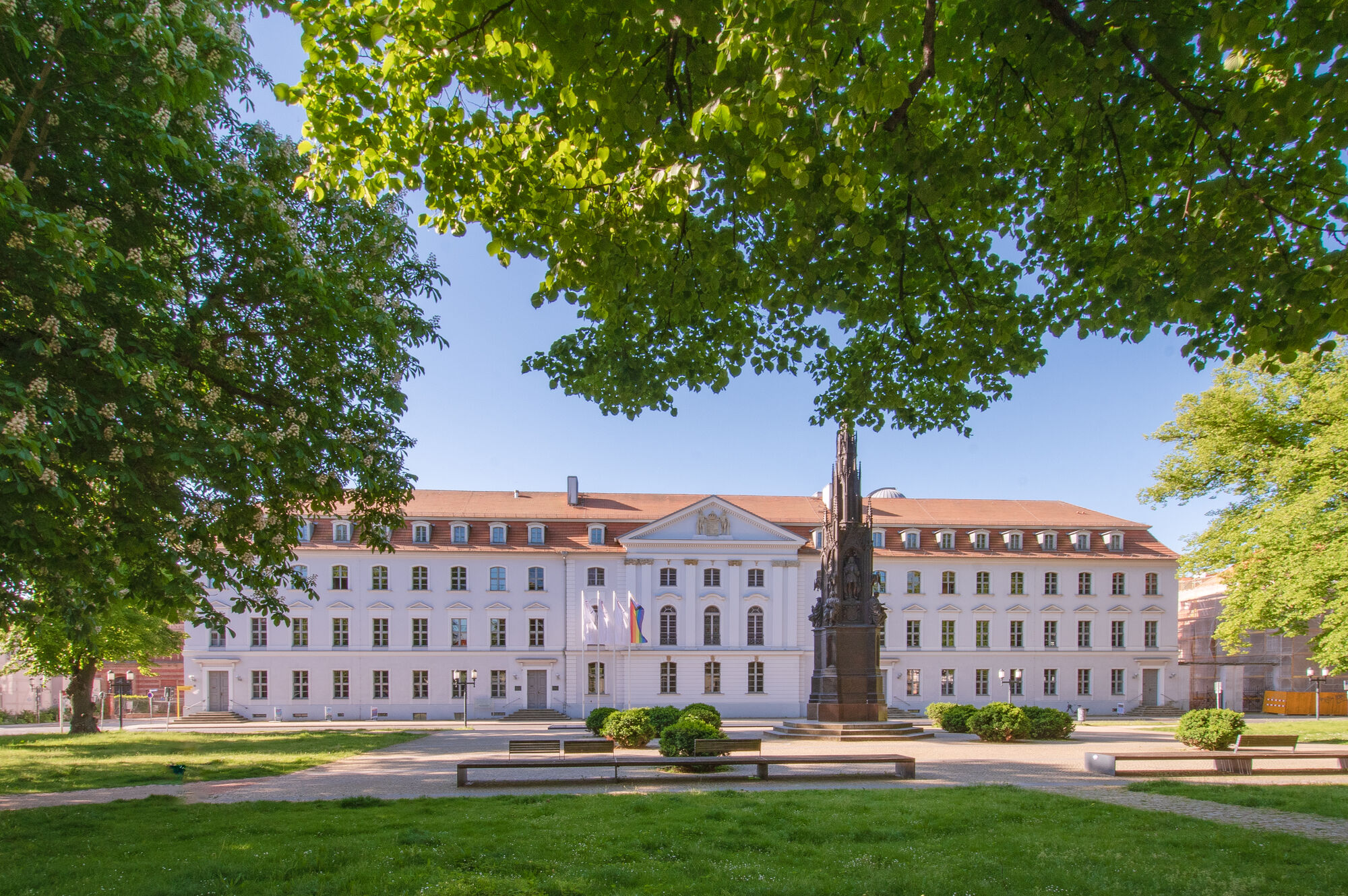On the occasion of the 275th anniversary of the official opening of the University of Greifswald’s Main Building on 28 April 2025, we speak to the Head of the University Archive Dr. Elisabeth Heigl about the story behind the construction project, former and current use, and she sheds light on what she considers to be the most unusual stories of the building’s past.
Why did the Main Building require reconstruction? Was it necessary or merely a means of self-fulfilment for master builder Andreas Mayer?
The predecessor of today’s Main Building, which was approximately the same size, was built on the same site in 1591. At an age of almost 160 years, the building had fallen into disrepair. Due to a lack of funds, damages to the outside and interior of the building kept being repaired in a makeshift manner. Following a number of wars, something had to be done. However, the urgent need for renovation did not stop the initiator and master builder Andreas Mayer from wanting to construct a monument in stone.
Which function did Andreas Mayer have in Greifswald?
Andreas Mayer came to the university as a professor of mathematics in 1741. He was a renowned pupil of the famous polymath Christian Wolff and maintained close contact with Swedish government circles – at that time, part of Pomerania that included Greifswald, was reigned by Sweden. Andreas Mayer became Rector in 1747 and immediately started his lobby work for the construction of a new building. He contacted and visited the most influential decision-makers in the region and beyond, such as the General Governor in Stralsund, who was the Swedish King’s governor in Swedish Pomerania.
With the approval of the Swedish crown in his pocket, he was surely more than prepared for any discussions at the university, right?
The Rector was not solely responsible for decision-making at the university, decisions were passed with the majority of the professors’ votes. Andreas Mayer managed to convince his predominantly critical colleagues with the argument that the new building would only cost 12,000 Reichstaler. At that time, the university had capital assets of approx. 16,000 Reichstaler. For comparison: An Ordinarius, i.e. a professor with professorial chair, received an annual salary of 200 Reichstaler in 1747.
Today’s building projects are notorious for exceeding the cost calculations. How accurate were the calculations of Andreas Mayer, who was a professor of mathematics?
When the building was officially opened at a ceremony in April 1750 – by the way, with a ceremonial address held in Latin by Anna Christina Balthasar, the daughter of a professor – some of the construction work had not been completed. Furthermore, instead of the 12,000 Reichstaler, it had by that point already cost 20,000 Reichstaler! This is proof that it is no modern-day phenomenon for building projects to exceed their deadlines and budgets. But Andreas Mayer had succeeded in setting his monument in stone that has survived the centuries. It has been renovated and marvelled upon on many an occasion. And still today, the architect is celebrated for providing the small university with such a magnificent building.
What did these increased costs mean for the university?
In theory, the university could afford it. Following the end of the Great Northern War in 1721, the Senate had managed to accumulate substantial financial reserves of approx. 16,000 Reichstaler in less than 20 years. The University lent money at interest throughout the region; to princes, civil servants, the gentry, tenants, craftsmen, widows, the church, and towns. Surpluses in the university’s funds were carefully reinvested, meaning that the financial assets increased steadily. In the 1740s the University of Greifswald had a sturdy financial footing for the first time in nearly 200 years. 12,000 Reichstaler was a feasible sum.
So, in theory, everything was OK – but what did things really look like?
In practice, no funds were available. Most of those who had borrowed money were not able to pay the money back at such short notice. They had invested it themselves, e.g. the carter had bought himself a new cart or the tenant had bought seed. Therefore, the University had to take out short-term loans even for the first building invoices. This meant that the University also saw itself confronted with increasing amounts of interest. Furthermore, building materials were becoming more and more expensive, e.g. because Andreas Mayer bought expensive new stones instead of recycling old stones as was common practice (#sustainability). He also commissioned expensive craftmanship work that had not been agreed. At the same time, the academic financial administrator Christoph Nürenberg, who had steered the economic success of Greifswald’s university for 20 years, passed away. Know-how and organisation skills were lost when he died: the financial administration fell into disarray and the burden of loans steadily increased. The new building thus turned the university’s assets into an enormous mountain of debt within just a few years (1747-1753).
That sounds like a very complex situation. Did Sweden get involved?
The Swedish Government reacted in its own way: instead of providing financial support to its oldest university, it ordered so-called visitations, i.e. financial and structural audits. At the end of the visitation process, the auditing committee found that Greifswald’s professors were incapable of financial management and demanded that they be relieved from this responsibility. The new Main Building cost the university not only more money than planned, it also caused them to lose a significant part of its autonomy.
Today’s Main Building is home to the Aula, the Rectorate and some of the central organisational units. How was the building used originally?
The magnificent Baroque building from 1750, as with its predecessors, had both public and private rooms. It served all members of the university community – i.e. lecturers and students. To match these needs, a large lecture hall (which is now the Conference Room) was created at the heart of the building, on the first floor, with the University Library (today’s Aula) on the two floors above. In addition, there was one further small lecture hall on both the first and the second floors, as well as an anatomic hall and the natural history collection. On the East and West ends of the building, i.e. where University Communications can be found on the one side today and Kustodie and the Gender Equality Office on the other, were apartments for professors who also held private reading sessions and even accommodated students in their rooms. The Konzilsaal, which was the conference room for the self-governing professors, and was adjoined by a records storage room, was located where the Rector and the Rectorate’s secretaries now have their offices. The Archive was located in two rooms below.
How has the original purpose of the building changed from then until now?
The purpose of the University Main Building, which, with its lecture halls, the library and at lease one academic collection, was intended as the focal point of academia and teaching – in line with the aims and objectives of the Enlightenment era – has changed considerably since its opening in 1750. From the second half of the 19th century onwards, purpose-built buildings (e.g. the University Library or the Auditorium Maximum) meant that less and less student and academic life took place in Domstraße 11. Instead, the building was used more and more for representative and administrative purposes.
Ms. Heigl, in your thesis you took, and in your current position as Head of the University Archive, continue to take an in-depth look at the history of the Main Building. What is the most unusual thing you have discovered so far?
I found the history of the magnificent Main Building as an economic disaster for the post-classical university, which I was able to (re)discover in the course of my research, particularly interesting. But I am also fascinated by the everyday logistical challenges of running such a heterogeneously used building. The account books reveal many seemingly trivial details, e.g. that the latrines were located in the courtyard behind the Main Building and that these were mainly cleaned, i.e. emptied or moved, by day laborers during the winter months. However, what I found particularly interesting was that plans for the building in 1750 aimed to reinstate something that had been discontinued since the 1650s due to considerable damage to the building: residential accommodation for students on the top floor. When I stand on the Rubenowplatz, I sometimes wonder what it would be like if there were still a small student hall of residence under the roof of the Main Building.
About Dr. Heigl
Dr. Elisabeth Heigl has been Head of the University of Greifswald’s Archive since 2024. She wrote her doctoral thesis on the financial administration of the University of Greifswald 1566-1806 and received her doctorate for the thesis in Greifswald in 2019.
Interview: Dr. Elisabeth Böker
Tours through the University Main Building
The University of Greifswald’s Kustodie (University Collections) offers a daily public tour of the Aula and Karzer (student detention cell) from 1 April to 31 October. Those interested do not need to register in advance. The tour begins at the Rubenow Memorial at 3.00 p.m. Come face to face with great thinkers and learn more about gifted doctors at the University of Greifswald. Get to know the history of Pomerania’s Alma mater and Sweden’s oldest university. Find out more about the university during the political upheavals of the last 200 years. We will show you our “parlour”, the Baroque Aula and give you a taste of prison life. You will be amazed by some of the crude pranks of student detainees in the past.
Contact at the University of Greifswald
Dr. Elisabeth Heigl
Head of the University Archive
Baderstraße 4/5, 17489 Greifswald
Tel.: +49 3834 420 1156
archivuni-greifswaldde


